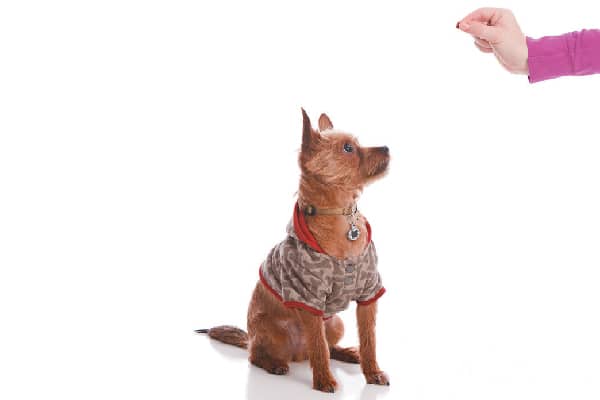Think You’ve Got a Stubborn Dog? How to Train a Dog Who Won’t Listen

[ad_1]
As a dog trainer, I hear expressions like “My dog is stubborn” or “My dog refuses to listen to me” on a weekly basis. I empathize with dog parents’ frustrations, while also empathizing with another species who can’t talk and who is most often not being defiant or stubborn. Think you’ve got a stubborn dog, or a dog who seems to ignore you or not listen?
Think you’ve got a stubborn dog? How you’re training your dog might be a big part of the problem. Photography ©Jamie Garbutt | Getty Images.
Is your dog being stubborn? Is your dog ignoring you?
So what’s happening when your dog seemingly ignores you, and what can you do about it?
We ask and expect a lot of our dogs, sometimes even expecting a new dog in the home to understand all of the house rules and boundaries on the first day!
Even with our language skills, you or I would need time to settle in to a new environment. Dogs need time to settle in as well. It doesn’t mean they can do unwanted things like knocking trash cans over — it means we need to be patient as we begin showing the dog his new home.
Step 1: Be patient when training a new (or old) dog new skills.
Understand that dogs really do need training. They don’t arrive already understanding our human-made house rules.
Step 2: Possess very clear communication skills.
Let’s take a dog continually jumping on people in the home. If one pet parent consistently asks for an incompatible behavior — let’s say a sit — and often rewards that sit, the dog will begin to sit and will cease jumping if he gets zero out of it.
But then when the other pet parent comes home from work, he or she enjoys the dog jumping up to say hello and inadvertently reinforces that behavior by playing with the dog, perhaps even patting him on the sides and talking joyfully to him. This dog is getting very mixed messages.
Some dogs are good at weaving their way through people in the same home reinforcing a behavior one day and other people correcting that same behavior another day. Most dogs are simply confused because we haven’t communicated the behavior we do want clearly enough. Agree on your house rules before you bring a dog into your home, and then all work together to reinforce the behavior wanted.
Step 3: Repetition, repetition, repetition.
I train new skills at home first because it’s a quiet, private space where I can control what’s happening in the environment. Imagine a young elementary school student trying to learn math problems with other kids running around the playground, chasing each other and laughing. It’s hard to focus.
You can set your training sessions up for success by first teaching your dog in a calm setting. Once you have reinforced your dog’s new skill with terrific food many, many times in the home, and once he’s giving you the asked-for behavior 90 percent of the time in that environment, then take it to the backyard or front porch (on leash in unfenced areas).
Be aware of your dog’s incredibly powerful nose that kicks into high gear outside or in new environments. You could first do a sniffing nose walk around your backyard and then begin the training session. Or, ask for something the dog knows well, such as a sit and just after he sits, tell him “Let’s go explore!” and walk or run around the yard.
Step 4: Realize that some things are harder than others for dogs.
Dogs do what works — for them. Therefore, it’s in our own best interest to have the behaviors we want for our dog work best for them as well. Two skills that seem hardest for dog parents to teach consistently are “leave it” and a solid recall. Both skills are vital and can even be life saving.
What is involved from the dog’s point of view in these two skills? His nose. It takes him right to that delicious piece of hamburger meat you accidentally dropped on the kitchen floor. And his nose is leading him to run away from you at a dead run while he chases the scent of the wild rabbit that hopped through his yard.
Instead of fighting that powerful nose, work with it. For example, when teaching “leave it,” ask your dog to leave a boring piece of kibble. The second he removes his nose from it, mark with a “Yes!” and give him a much better-smelling meat reward. A dog can learn to leave things once he understands that doing so will get him a much better reward.

Remember — treats like meat and cheese go a long way when training a stubborn dog! Photography ©mdmilliman | Getty Images.
Teaching even a stubborn dog a good recall
Entire books and DVDs have been created to help dog parents teach a solid recall, something all dogs should know. While we don’t have the space here to delve deep into this cue, I can give you some quick pointers.
Begin teaching a recall off leash inside your home. Use your cue word to call your dog in for meals. Use your cue to call your dog for a walk. Reinforce recalls with truly wonderful meat or cheese reinforcers when your dog does come to you. Call your dog five to 10 times a day in your home and back up as he comes bounding to you to engage him even more.
Praise and treat, praise and treat. When he is super excited to come to you, take it outside to your backyard or other calm, fenced location. Do not punish a dog who is coming to you, even if it took him longer than you wished.
The final word on teaching a stubborn dog or a dog who seemingly doesn’t listen
All in all, it’s far more likely that we need to take a step back in our own communication skills than it is that a dog is purposefully ignoring us. We have the bigger brain (and thumbs!), so let’s work to employ that intelligence and set our dogs up to succeed.
Still need help training a stubborn dog?
So, what if you have done all the recommended steps above and Fido STILL ignores you? Here are some other things to consider:
- What reinforcers are you using and are they truly exciting for your dog? Some dogs, for example, will do anything for a chance to play fetch, so a ball outranks a piece of cheese.
- Is the skill too new for the environment you are asking your dog to demonstrate?
- Have you insufficiently trained the skill in a calm setting first?
- If your dog is ignoring your cue, back up in his training to the last spot where he was
performing well, and start anew from that spot. - Keep in mind that some dogs do seemingly go a bit deaf as they go through adolescence. Keep with the program, and you will have a nicely trained mature dog on the other side of the teenage years.
Thumbnail: Photography ©LightFieldStudios | Getty Images.
Read Next: Whale Eyes in Dogs — What It Means When the Whites of Your Dog’s Eyes Show
[ad_2]
Source link






